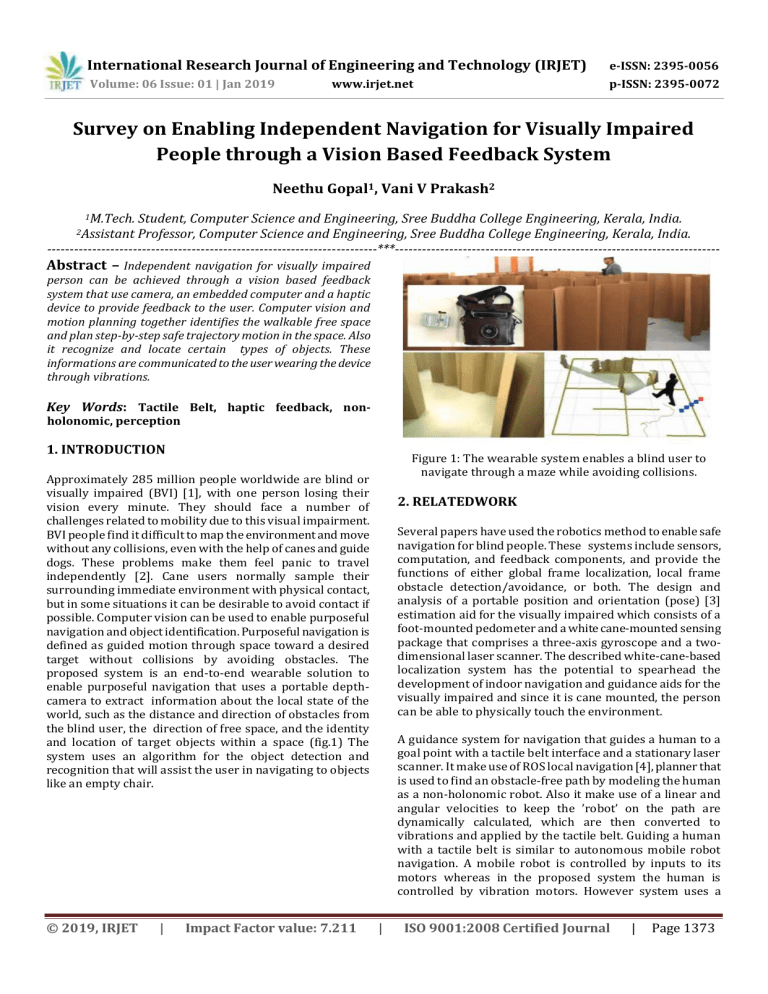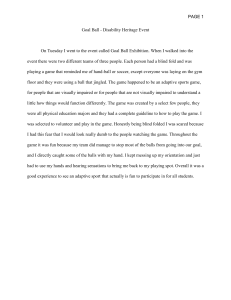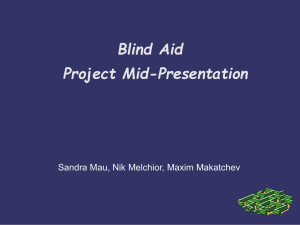IRJET-Survey on Enabling Independent Navigation for Visually Impaired People through a Vision based Feedback System
advertisement

International Research Journal of Engineering and Technology (IRJET) e-ISSN: 2395-0056 Volume: 06 Issue: 01 | Jan 2019 p-ISSN: 2395-0072 www.irjet.net Survey on Enabling Independent Navigation for Visually Impaired People through a Vision Based Feedback System Neethu Gopal1, Vani V Prakash2 1M.Tech. Student, Computer Science and Engineering, Sree Buddha College Engineering, Kerala, India. Professor, Computer Science and Engineering, Sree Buddha College Engineering, Kerala, India. -------------------------------------------------------------------------***-----------------------------------------------------------------------2Assistant Abstract – Independent navigation for visually impaired person can be achieved through a vision based feedback system that use camera, an embedded computer and a haptic device to provide feedback to the user. Computer vision and motion planning together identifies the walkable free space and plan step-by-step safe trajectory motion in the space. Also it recognize and locate certain types of objects. These informations are communicated to the user wearing the device through vibrations. Key Words: Tactile Belt, haptic feedback, nonholonomic, perception 1. INTRODUCTION Figure 1: The wearable system enables a blind user to navigate through a maze while avoiding collisions. Approximately 285 million people worldwide are blind or visually impaired (BVI) [1], with one person losing their vision every minute. They should face a number of challenges related to mobility due to this visual impairment. BVI people find it difficult to map the environment and move without any collisions, even with the help of canes and guide dogs. These problems make them feel panic to travel independently [2]. Cane users normally sample their surrounding immediate environment with physical contact, but in some situations it can be desirable to avoid contact if possible. Computer vision can be used to enable purposeful navigation and object identification. Purposeful navigation is defined as guided motion through space toward a desired target without collisions by avoiding obstacles. The proposed system is an end-to-end wearable solution to enable purposeful navigation that uses a portable depthcamera to extract information about the local state of the world, such as the distance and direction of obstacles from the blind user, the direction of free space, and the identity and location of target objects within a space (fig.1) The system uses an algorithm for the object detection and recognition that will assist the user in navigating to objects like an empty chair. © 2019, IRJET | Impact Factor value: 7.211 2. RELATEDWORK Several papers have used the robotics method to enable safe navigation for blind people. These systems include sensors, computation, and feedback components, and provide the functions of either global frame localization, local frame obstacle detection/avoidance, or both. The design and analysis of a portable position and orientation (pose) [3] estimation aid for the visually impaired which consists of a foot-mounted pedometer and a white cane-mounted sensing package that comprises a three-axis gyroscope and a twodimensional laser scanner. The described white-cane-based localization system has the potential to spearhead the development of indoor navigation and guidance aids for the visually impaired and since it is cane mounted, the person can be able to physically touch the environment. A guidance system for navigation that guides a human to a goal point with a tactile belt interface and a stationary laser scanner. It make use of ROS local navigation [4], planner that is used to find an obstacle-free path by modeling the human as a non-holonomic robot. Also it make use of a linear and angular velocities to keep the ’robot’ on the path are dynamically calculated, which are then converted to vibrations and applied by the tactile belt. Guiding a human with a tactile belt is similar to autonomous mobile robot navigation. A mobile robot is controlled by inputs to its motors whereas in the proposed system the human is controlled by vibration motors. However system uses a | ISO 9001:2008 Certified Journal | Page 1373 International Research Journal of Engineering and Technology (IRJET) e-ISSN: 2395-0056 Volume: 06 Issue: 01 | Jan 2019 p-ISSN: 2395-0072 www.irjet.net stationary laser scanner which loses track if the human navigates to another room. 3) Some questions may not be answered, and 4) Questions may take some time to answer. Another system which is composed of a smartphone interface, a glass mounted RGBD-camera device, a real time navigation algorithm and a haptic feedback system. Orientation information of the blind user is extracted by the navigation algorithm that performs real-time 6-DOF [5],feature based visual odometry using a glass mounted RGBD- camera as an input device. The system achieves realtime performance at 28.4 Hz in average on a laptop. A product in development called BrainPort[10], uses a camera mounted on a pair of sunglasses as its input device. After processing the images they are displayed on the tongue via a “lollipop” like display. The “image” has been depicted as “tasting” a bit like effervescent champagne bubble on the tongue. An indoor navigation wearable system based on visual markers recognition and ultrasonic obstacles, perception used as an audio assistance for blind people [6]. The visual markers identify the points of interest in the environment, additionally this location status is enriched with information obtained in real time by other sensors. The user also use glasses built with sensors like RGB camera, ultrasonic, magnetometer, gyroscope, and accelerometer enhancing the amount and quality of the available information. The system offered an audio assistance when recognized a visual marker on the environment and warned about potential obstacles unmapped, located on the route. In this new era of technology a real-time wearable system is presented, which includes a camera, an embedded computer and embedded vibration motors in a belt with that provides vibration feedback to signal obstacles to its users. Braille displays provides high-level feedback in a discrete way, but with longer reaction times due to sweeping of the fingers on the braille cells. While audio feedback was deemed undesirable given the low refresh rate and long latency, as well as potential obstruction of other sounds, a major source of environmental cues for blind people. For the future enhancement it is recommended to introduce a stereo vision camera for outdoor capability and a large library for object recognition. 3. CONCLUSION Related Work of Computer Vision Based Assistive Technology for Visually Impaired: [7], many electronic mobility assistant systems are developed based on converting sonar information into an audible signal for the visually impaired persons to interpret. The “vOICe” [8], system is a commercially available vision-based travel aid that displays imagery through sound using videos captured by a head-mounted camera to help them build a mental image about the environment. The vOICe system translates images into corresponding sounds through stereo headphones, which will seriously block and distract the blind users hearing sense a training and education process is must conducted to understand the meanings of different ones and pitches of sounds about the environment. VizWiz is a free iPhone app[9], to provide answers to questions asked by blind users about their surroundings through anonymous web workers and social network members. With VizWiz, a user takes a picture and records a question on their mobile phone, then sends their question to anonymous workers, object recognition software – IQ, Twitter, or an email contact. When an answer is received from any of those services, which will sent back to the users' phone. The advantage of VizWiz is the fusion of automatic image processing software with human replies from other members in user's social network. However, there are several main limitations for blind navigation and way finding. REFERENCES 1) World Health Organization. [Online]. Available: http://www.who.int/mediacentre/factsheets/fs282 /en/ 2) R. Golledge, J. Marston, and C. Costanzo, “Attitudes of visually impaired persons towards the use of public transportation,” J. Vis. Impairment Blindness, vol. 90, pp. 446–459, 1997. 3) J. A. Hesch and S. I. Roumeliotis, “Design and analysis of a portable indoor localization aid for the visually impaired,” International Journal of Robotics Research, vol. 29, no. 11, pp. 1400–1415, Sep. 2010. 4) A. Cosgun, E. A. Sisbot, and H. I. Christensen, “Guidance for human navigation using a vibrotactile belt interface and robot-like motion planning,” in Robotics and Automation (ICRA), 2014 IEEE International Conference on. IEEE, 2014, pp. 6350–6355. 5) A. S. Huang, A. Bachrach, P. Henry, M. Krainin, D. Maturana, D. Fox, and N. Roy, “Visual odometry and mapping for autonomous flight using an rgb-d camera,” in Int. Symposium on Robotics Research (ISRR), Flagstaff, Arizona, USA, Aug. 2011. 1) The blind users have difficulty to aim their iPhone to the targeted objects 2) The answers the user received, there is no way to validate whether the answer is accurate. © 2019, IRJET | Impact Factor value: 7.211 6) Y. H. Lee and G. Medioni, “Wearable rgbd indoor navigation system for the blind,” in Computer | ISO 9001:2008 Certified Journal | Page 1374 International Research Journal of Engineering and Technology (IRJET) e-ISSN: 2395-0056 Volume: 06 Issue: 01 | Jan 2019 p-ISSN: 2395-0072 www.irjet.net Vision-ECCV 2014 Workshops. Springer, 2014, pp. 493–508. 7) Y. H. Lee and G. Medioni, “A rgb-d camera based navigation for the visually impaired,” in RSS 2011 RGBD: Advanced Reasoning with Depth Camera Workshop, 2011. 8) Seeing with Sound–The http//www.seeingwithsound.com/. vOICe: 9) “VizWiz - Take a Picture, Speak a Question, and Get an Answer.” Available: http://vizwiz.org/. BIOGRAPHIES Neethu Gopal, she is currently pursuing Master’s Degree in Computer Science and Engineering in Sree Buddha College of Engineering, Elavumthitta, Kerala, India. Her research area of interest includes the field of Internet of Things, data mining and data analytics in Department of Computer Science and Engineering. © 2019, IRJET | Impact Factor value: 7.211 | ISO 9001:2008 Certified Journal | Page 1375



